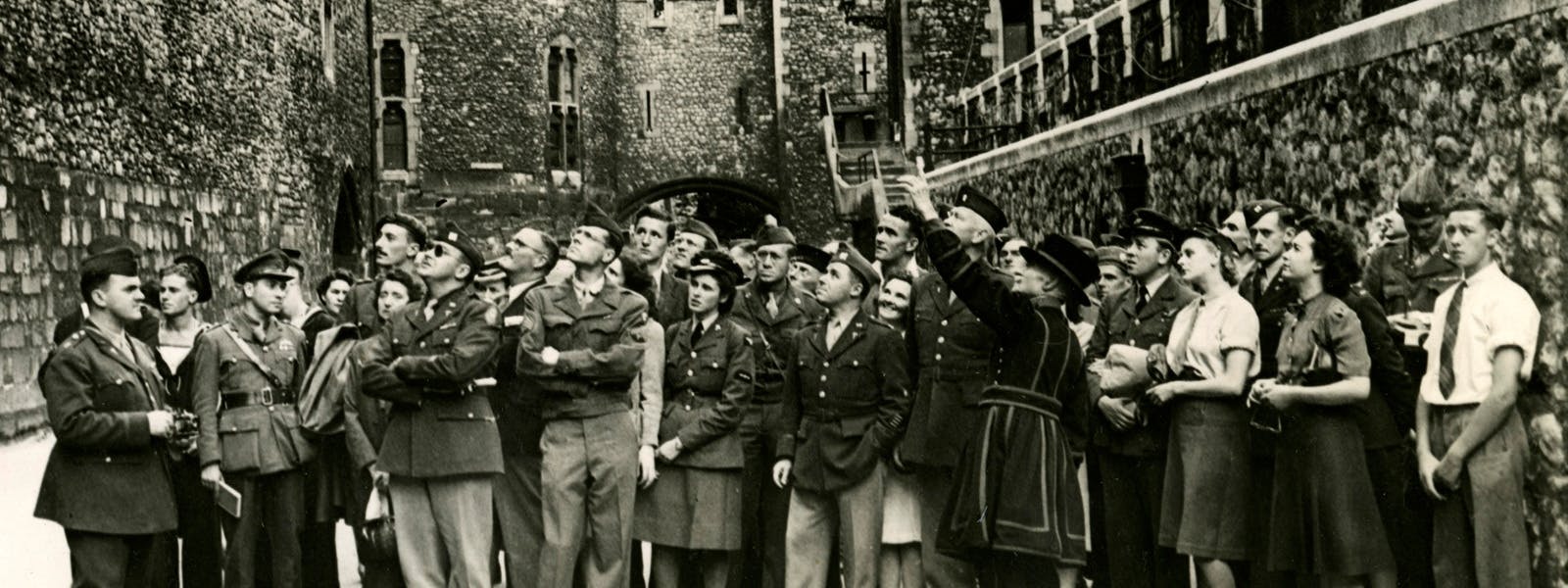
The Tower of London played an important role in the First and Second World Wars.
From training WWI recruits in the Tower moat including the Royal Fusiliers (whose headquarters and museum still exists at the Tower of London today), to guarding the infamous Nazi prisoner of war Rudolph Hess, during each devastating conflict the Tower returned to its former role as a military store, barracks and prison. And it became, once again, a grim place of execution for enemies of the state. A total of 12 spies were executed behind the Tower's walls.
In 2014 and again in 2018, The Tower of London commemorated the centenary of WWI with two major installations. In 2014, ‘Blood Swept Lands and Seas of Red’ marked Britain’s first full day of involvement in the war by filling the moat with 888,246 ceramic poppies while in 2018, ‘Beyond the Deepening Shadows: The Tower Remembers’ saw the moat filled with thousands of flames that commemorated those who lost their lives.
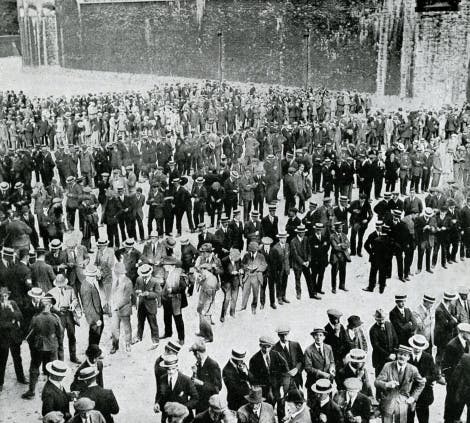
The City of London recruits
Within days of Britain's announcement to enter WWI, young men who worked near the Tower in the City answered the call to enlist. Some formed volunteer brigades with friends or work colleagues. 1300 men who worked for city firms joined the City of London Battalion, pictured here in the Tower moat, waiting to swear the oath of allegiance.
Image: © Illustrated London News Ltd/Mary Evans
The First World War
1914-1918
By the turn of the 20th century, the Tower of London was seen as a tourist attraction, but the Tower never formally dissolved its function as a garrison, prison and execution site.
The fortress actively carried out all three roles during the war, even as it remained open to visitors.
Marching out to the front line
Armed forces began to mobilise around the country and soldiers were garrisoned at the Tower of London, awaiting deployment. Men from the Second Battalion Scots Guards, pictured here, left from the Tower to go to the front line in France.
Espionage in Britain
Almost as soon as war was declared, enemy agents began to enter Britain. What's remarkable about their stories is how little training they received before being sent to carry out acts of espionage and many were captured easily.
In 1915, the British Army Head Quarters for the London District wrote to the Tower Constable suggesting that the execution of spies in the fortress would have 'more effect on the country at large and, possibly in Germany than an ordinary prison would have'.
By 1916, a total of 11 spies had been executed by firing squad within the Tower's walls.
Did you know?
The spies who were executed in the Tower were of various nationalities: German, Swedish, Uruguayan and Brazilian.

Carl Hans Lody
The first spy executed at the Tower of London
Carl Hans Lody was one of the first prisoners of war to be held and executed at the Tower of London. Lody, a German naval officer, arrived in Britain at the outbreak of the war in the summer of 1914. He was part of a network of spies sent to strategic positions around the country. A fluent English speaker, Lody posed as an American. He made his way to Scotland, under orders to observe and gather information on a fleet of warships anchored at Rosyth, a Royal Navy base near Edinburgh.
Lody admitted he felt 'uneasy' and that he was 'not a fit man for that kind of job'. He was well-known to many people internationally from his time escorting tourists on the Hamburg-America shipping line before the outbreak of war.
With no formal training, Lody was unprepared for a life of espionage. His true identity was quickly uncovered by M15, and he was captured and brought back to London to be tried by court martial.
Image: © Alamy Stock Photo
Carl Hans Lody on Trial
Lody's court martial took place at the Middlesex Guildhall in Westminster on 30 October and lasted until 2 November 1914. During his trial, it was said that Lody looked more like a typical clerk rather than a dangerous spy.
Witnesses were called to testify. The elderly proprietress of the Edinburgh boarding-house, where Lody had stayed, found it difficult to identify Lody. Lody stood up in the dock and waved his hands to attract her attention and nearly broke into laughter at the strange situation he found himself in.
When the court asked Lody, 'Who sent you to England?' he hesitated and went pale. He had pledged his word of honour and refused to reveal who had sent him.
On the final day of court, Lody was found guilty and sentenced to death.
Imprisoned at the Tower
Lody was held in Wellington Barracks before and during his trial. After his conviction, the Major of the Tower of London was informed there was a very short amount of time to prepare and secretly carry out the sentence.
The War Office approved the Tower of London as the location where Lody would be executed. The date was set for the morning of the 6th November 1914.
Three days later, Lody was taken to the Tower.
Convicted and condemned, he wrote a letter to the Commanding Officer of the 3rd Battalion Grenadier Guards expressing his 'sincere thanks and appreciation towards the staff of officers and men' who treated him kindly during his imprisonment at the Wellington Barracks.

My dear ones... Tomorrow I shall be shot here in the Tower. I have had just judges, and I shall die as an officer, not a spy. Farewell. God bless you, Hans.
Lody's final letter to his family. Photograph of Lody, © The British Library Board, 010705.i.35
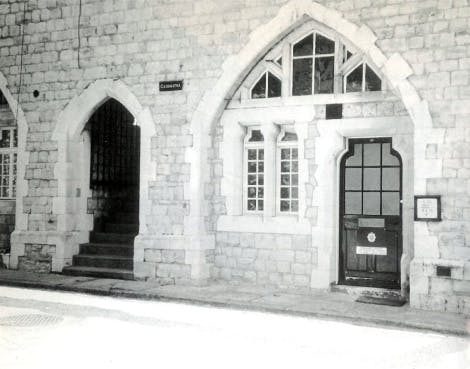
Lody's Final Walk
On the morning of execution, as Lody was led away from his cell by an officer, he said, ‘I suppose that you will not shake hands with a German spy?’
The officer replied, ‘No. But I will shake hands with a brave man.’
The Tower Chaplain read the burial service, leading a calm and composed Lody through the Tower, while armed escorts and the guards, who were to carry out his sentence, followed closely behind.
Image: No29, The Casemates, where Lody was imprisoned.

A Yeoman Gaoler witnesses Lody's execution
In his memoir, 'Sixty Years in Uniform' published in 1939, Yeoman Gaoler John Fraser recalled Lody's final moments before his execution.
'The Chaplain, in his nervousness, made to turn left, which was the wrong way. Instantly Lody took a quick step forward, caught the Chaplain by the right arm, and, with a polite and kindly smile, gently guided him to the right – the correct way...
A few moments later the procession disappeared through the doorway of the sinister shed, and shortly after that came the muffled sound of a single volley.'
Image: Yeoman Warder John Fraser RVM. © Historic Royal Palaces / Yeoman Warder Archive
Carl Hans Lody's burial in East London
After Lody's execution, the Tower opened its doors to visitors the same day. During his trial, Lody had written to a friend that his 'body shall have been placed in the concrete beneath this old Tower'. In fact, Lody was buried in an unmarked common grave in the East London Cemetery in Plaistow.
Sometime after, the War Graves Commission erected a wooden cross on Lody's grave and his family added a white headstone. The headstone was destroyed by bombing during WWII but was replaced by relatives in 1974. The War Graves Commission and the German Embassy created a memorial for German civilians buried in the cemetery, including the other spies that were later executed at the Tower. A small stone marks their resting place.
The WW1 spies executed at the Tower
In total, 11 spies were executed within the Towers walls from 1914 to 1916. They were:
- Carl Frederick Muller, executed 23 June 1915
- Haicke Petrus Marinus Janssen and Willem Johannes Roos, executed 30 July 1915
- Ernst Waldemar Melin, executed 10 September 1915
- Augusto Alfredo Roggen, executed 17 September 1915
- Fernando Buschmann, executed 19 October 1915
- George Traugott Breeckow, executed 26 October 1915
- ‘Irving Guy Ries’, executed 27 October 1915
- Albert Meyer, executed 2 December 1915
- Ludovico Hurwitz-y-Zender, executed 11 April 1916
The interwar years
1919-1938
The years between World War I and World War II saw the Tower of London resume its role as a tourist attraction and continue its military traditions and royal ceremonies while diplomatic visits took centre stage.
1923
The Royal Munster Fusiliers, an Irish infantry regiment of the British Army, took part in the ‘Laying up of the Colours’ in 1923, an annual ceremony where regiments raise their official colours. The practise of carrying colours was to act as a rallying point for military troops and to mark the location of the troop commander.
Image: © Military History Collection / Alamy Stock Photo

1924
Ras Tafari, later Haile Selassie, (to the far right, wearing a bowler hat) visited the fortress during his tour of Europe and the Middle East in 1924. He was Ethiopia's regent from 1916 to 1930 and its 225th (and last) Emperor from 1930 to 1974.
Image: © Historic Royal Palaces Image Library

1928
Prince Potenziani, Governor of Rome with his daughter, Princess Donna Myriam (centre left), visited the Tower of London on 11 June 1928, accompanied by the Lord Mayor and Lady Mayoress of London.
The party are pictured outside the Main Guard (left), built 1899 and 1900, but destroyed by an incendiary device in 1940. The building contained a guard room, orderly room, office, stores, a recreation area, mess and lecture rooms.
Image: © Historic Royal Palaces Image Library
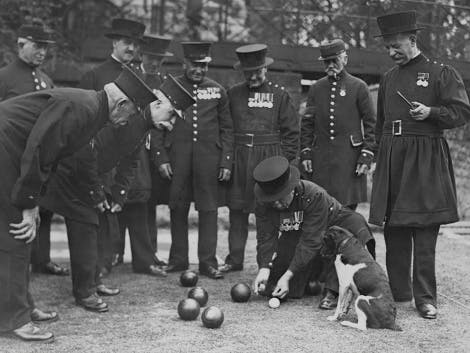
1929
Yeoman Warders and Chelsea Pensioners playing bowls in 1929 in the south moat near the Byward Tower. The Royal Hospital Chelsea, where Chelsea Pensioners reside, was founded by Charles II in 1682.
Image: © Historic Royal Palaces Image Library

1931
In 1931, U.S child envoys visited England to extend greetings to British children to foster international goodwill. Colonel Burges, Victoria Cross Recipient and Resident Governor of the Tower, greeted the party.
Image: © Historic Royal Palaces Image Library

1936
Lieutenant-Colonel William Fredrick Faviell, Resident Governor of the Tower of London, reading the Proclamation of Accession of King George VI to the Yeoman Warders on Tower Green in 1936.
Image: © Historic Royal Palaces Image Library / Yeoman Warder Archive

1937
The wedding of James Hart Rutland and Jean Milne at St Peter ad Vincula in 1937. Jean Milne was the daughter of British Field Marshal Lord Milne, who was appointed Lieutenant of the Tower in 1920 and served in the Second Battle of Ypres in World War One.
Image: © Mary Evans / Imagno
The Second World War
1939-1945
As the summer of 1939 turned to autumn, the prospect of war became inevitable. In preparation the Tower closed to the public on 26 August 1939. By 3 September, Britain declared war against Germany. If London was invaded, the fortress would become a stronghold to defend the city, as it had been for over a thousand years.
This time the war was closer to home, with the Tower of London facing the threat of bomb damage and its residents fearing for their lives.
Soldiers in the White Tower
The Tower Armouries, one of the oldest institutions at the fortress, removed objects from the collection, including Henry VIII’s royal armour. Tower residents were issued with gas masks and steel helmets, and prepared themselves for regular blackout drills.
By autumn, the vacated galleries in the White Tower were re-purposed for the military. Chambers were used as a sports room and concert hall for troops, with a canteen and library on the ground floor and an air raid shelter in the basement. The famous execution block and axe was put on display for soldiers, while the Tower Armouries gave lectures and tours on historic arms and armour.
Did you know?
The Crown Jewels were removed, although where they were stored remains a mystery to this day.

Prisoners of war at the Tower
The Tower Prisoner of War Collection Centre was set up on 3 September to house prisoners of war for interrogation before they were sent on to prison camps.
Wounded prisoners were placed in the Old Hospital Block, while others stayed in the New Armouries and the Main Guard. The centre eventually moved to North London, as the Tower ran out of space to detain the large number of prisoners.
Image: The Old Hospital Block, Tower of London. © Historic Royal Palaces Image Library

Dig for Victory!
The government introduced a campaign calling for the public to turn green spaces into allotments.
Lawns, flower beds, sports pitches, gardens and parks were transformed into vegetable patches as The Ministry of Agriculture urged the British people to Dig for Victory!
The propaganda campaign aimed to make sure people had enough food to keep and to keep morale high.
Britain imported a great deal of its food and German U-boat attacks on merchant shipping exposed the public to the threat of starvation.
Image: Dig for Victory poster © Hi-Story / Alamy Stock Photo

The Tower of London's moat becomes an allotment
The residents of London's East End, where the Tower of London is situated, followed the Government’s encouragement to grow vegetables.
Everyone was expected to 'do his or her bit' to help the war effort as the government began to ration food.
The Tower of London was no exception, and the Tower's moat became an allotment.
Image: Yeoman Warders Burrows (foreground), Stevens and Box can be seen 'digging for victory' © Historic Royal Palaces Image Library / Yeoman Warder Archive
The Blitz
The British Government enforced a blackout from 1 September 1940 in expectation of a civilian bombing campaign by German bombers.
From 7 September 1940 to 10 May 1941, London and then the rest of the United Kingdom experienced nightly aerial bombardment in what came to be known as the 'Blitz'.
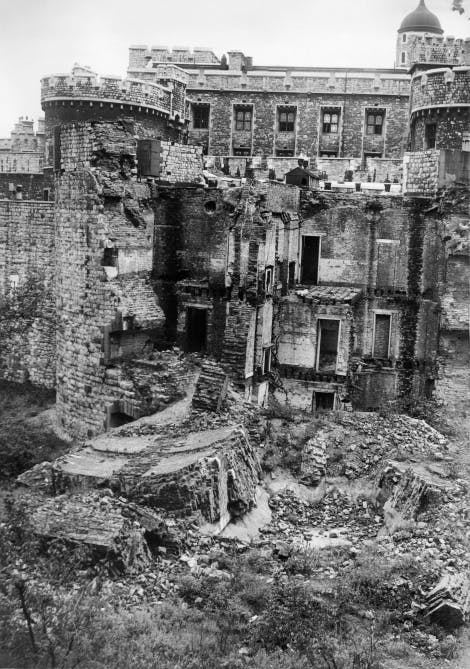
Bomb damage at the Tower
The East End of London became a strategic target for the German bombers in a plan to destroy the docks and warehouses that lined the Thames.
Whereas the only German bomb to fall on the Tower during the First World War landed harmlessly in the Moat, the aerial bombardment of the Second World War caused huge damage to the Tower.
On the night of 23 September 1940, high-explosive bombs were dropped on the Tower, destroying a large section of the Mint and the Old Hospital Block to the east of the White Tower.
More raids followed. On 5 October a bomb struck the fortress, blowing apart the massive North Bastion and narrowly missing the White Tower. Tragically, Yeoman Warder Reeves was killed in the blast.
Image: The North Bastion after being struck by a bomb © Historic Royal Palaces Image Library / Yeoman Warder Archive
Air Raid Damage at the Tower
This plan of the Tower of London records the locations of bomb strikes between September and December 1940.
View this document in high definition in this Gigapixel image, created in partnership with Google Arts & Culture.

Rudolf Hess and the Tower of London
During the Second World War, the Tower again became a prison for high status prisoners.
The most high-profile of these was Rudolph Hess, deputy Führer of the Nazi party and Adolf Hitler’s right-hand man.
On 10 May 1941 Rudolf Hess lowered himself into the cockpit of a Messerschmitt plane and took off from an airfield in Augsburg, Bavaria on a solo flight to Scotland. He ejected from his plane and parachuted into the field outside Glasgow.
The purpose of Hess' mission remains one of the great unresolved mysteries of the Second World War.
Image: Rudolf Hess in a sport airplane, 1934 © Mary Evans / SZ Photo / Scherl
Hess imprisoned in the Tower
Some suggest Hess intended, with or without Hitler's permission, to negotiate a peace between Germany and the United Kingdom. Others believe he was lured to Britain by the British Secret Intelligence Service.
Whatever his motives, Hess was captured and taken to the King's House at the Tower of London on 17 May 1941, where many prisoners had been interrogated, including Guy Fawkes. Lodged under the tightest security, he was questioned for four days until he was removed from the Tower. He spent the rest of the war as a prisoner at Mytchett Place, Surrey. At the Nuremburg Trials of 1946, Hess was sentenced to life imprisonment in Spandau, west Berlin, where he remained until his death in 1987, aged 93.
Hess was the last state prisoner to be held at the Tower.

Josef Jakobs
The last spy to be executed at the Tower
Josef Jakobs was the last spy to be executed at the Tower during World War II. Jakobs was conscripted into the German army during WWI, where he was shot in the chest on duty. He recovered and worked as a dentist. When the Nazi Party rose to power, he sold black market passports to Jewish people fleeing the country. He was eventually arrested by the Gestapo and sent to the Sachsenhausen concentration camp in 1938.
After two years, Jakobs was released in exchange for working as a spy in England for the German military intelligence. Like Carl Hans Lody, Jakobs was not suited for espionage, but the government needed agents for risky missions. Allegedly, Jakobs confided to a friend that he planned to help the British Intelligence so that he could secure safe passage to America.
Jakobs' capture
Jakobs was captured on 1 February 1941 by two farmworkers after he was injured whilst parachuting into England. He claimed he had arrived from Hamburg and wasn’t part of the war, but he was found with a wireless transmitter, a small torch with a flashing device and a map that marked the nearby positions of the RAF aerodrome in Upwood and the satellite airfield in Warboys.
Image: Photograph of Josef Jakobs. © Giselle K. Jakobs
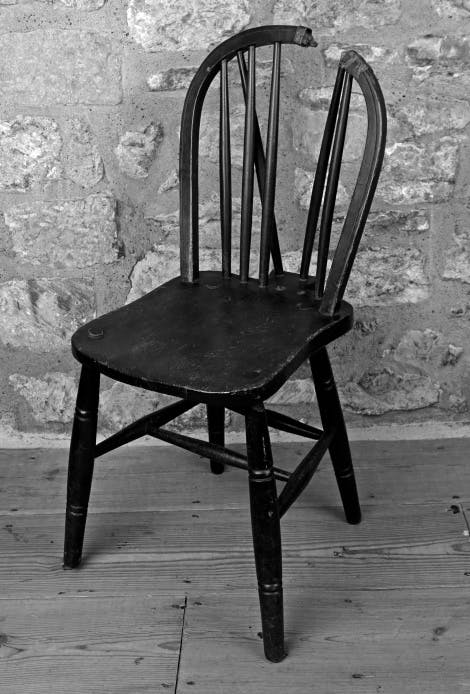
Jakobs' execution at the Tower
In late July 1941, Jakobs was transferred from MI5's interrogation centre to Wandsworth Prison to await his court martial, which took place at the Duke of York Headquarters in Chelsea, London.
He was found guilty and sentenced to death by firing squad at the Tower of London.
While awaiting his fate, he wrote to his wife, Grete, ‘Dear, best wife, thousands and thousands of time over, thank you for all the good you have done for me.’ He ended the letter with ‘Aufweidersehn’, meaning ‘until we see each other again’.
Jakobs was executed on 15 August 1941 in the miniature rifle range, where the 11 spies were executed during WWI. He was buried in an unmarked grave in St Mary’s Roman Catholic Cemetery in north-west London.
Image: Josef Jakobs was executed in this chair, which is still on display in the White Tower. © Royal Armouries
Watch Footage of the Tower of London Bombed (1941)
The video shows shots of the Tower of London, the day after a heavy air raid. One of the towers was bombed, causing part of it to collapse. Watch this original footage, which features shots of piles of rubble in the Moat and Civil Defence Workers scrambling over ruins.
The Tower after the war
1945 - present day
On 8 May 1945 the allied forces declared Victory in Europe and the celebrations that followed became known as VE day. The East-End of London celebrated with a week of street parties, although the shadow of all the lives lost hung over all the festivities. The war against Japan continued and many soldiers were still serving overseas. The effects of the war would be felt for many years.
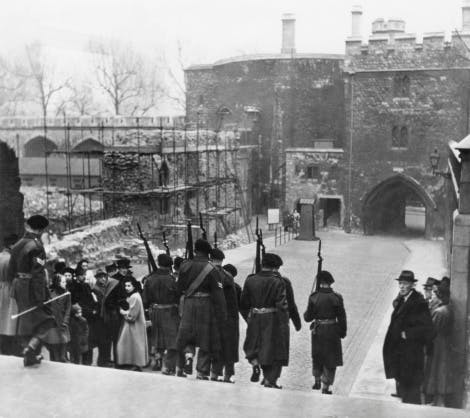
The Tower reopens
The Tower re-opened to tourists in 1946, although it was sadly changed: the bomb damage was highly visible and yet to be cleared.
Image: Visitors return to the Tower of London after the end of the Second World War. © Historic Royal Palaces Image Library

The Tower remembers
In 2014 and again in 2018, the Tower transformed into a site of remembrance and reflection for those who lost their lives in both WWI and WWII.
In 2014 the Tower of London marked the centenary of the outbreak of The First World War (WW1) with the commemorative art installation ‘Blood Swept Lands and Seas of Red’, which saw the moat filled with thousands of ceramic poppies.
Inside the Tower, a panel commemorating the 12 spies who were executed in both world wars was installed along the battlements between Martin Tower and Constable Tower, in view of where the rifle range once existed.
In 2018 the Tower once again became a site of commemoration, marking 100 years since the end of WWI with Beyond the Deepening Shadow. The nightly candle lighting ceremony in the moat was led by the Yeoman Warders and created a circle of light radiating from the Tower as a symbol of remembrance.
Image: Yeoman Warder Moira Cameron fulfilling her ceremonial duty at the 'Beyond the Deepening Shadow' public event. © Historic Royal Palaces
BROWSE MORE HISTORY AND STORIES

Edward Francis
Edward Francis, an enslaved African who lived at the Tower of London

Lady Jane Grey
Known as the ‘Nine Day Queen’, Lady Jane had the shortest reign in British history
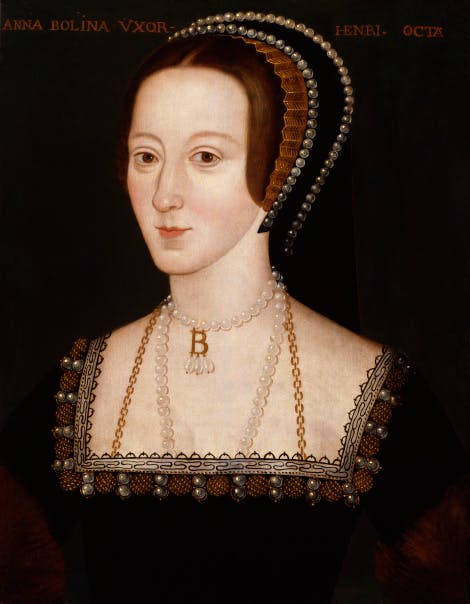
Anne Boleyn
How did Anne Boleyn become queen and why did Henry VIII execute her?
EXPLORE WHAT'S ON

- Tours and talks
Ceremony of the Keys
Be part of this ancient tradition, which has taken place every night for at least 700 years in the Ceremony of the Keys at the Tower of London.
- Daily
- From 21:30-22:05
- Tower of London
- Separate ticket (advance booking required)

- Tours and talks
Audio Guide Tour
Explore deeper with the Tower of London audio guide tour. Discover extra information about the Tower's history, plan your day and find out more about our cafés and shops.
- Available
- Tower of London
- Separate ticket

- Things to see
Imprisonment at the Tower exhibition
Learn why people ended up as prisoners in the Tower of London, in the very rooms where some of them were held.
- Open
- Tower of London
- Included in palace admission (members go free)
Shop online

Shop Raven gifts
Legend has it that if the six ravens ever leave the Tower of London, the Tower and the kingdom will fall. These products have been inspired by the Ravens that live at the Tower of London.
From £3.00
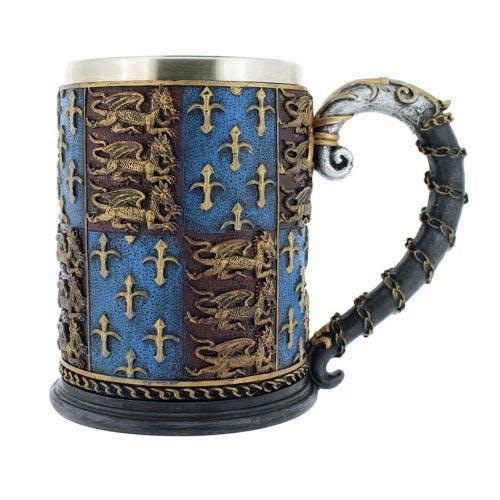
Medieval knights tankard
Medieval knights tankard inspired by the royal arms of England. Featuring intricate dragon detailing this beautifully designed mug has a detailed chain entwined around the handle. Perfect for re-enactments or a gift for someone who loves all things medieval.
£30.00

The story of the Tower of London
Explore the stories that come from the historic home of royal power in England - the Tower of London.
£14.95


